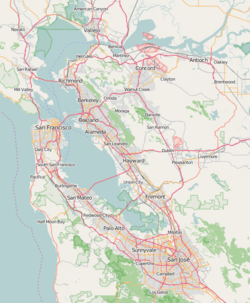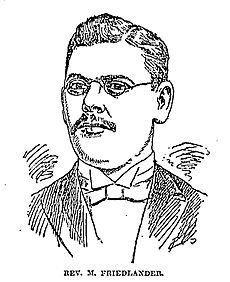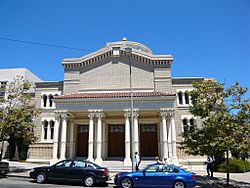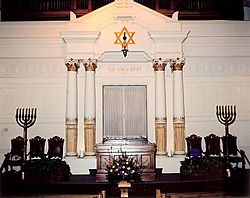Temple Sinai (Oakland, California) facts for kids
Quick facts for kids Temple Sinai |
|
|---|---|

The synagogue building, in 2008
|
|
| Religion | |
| Affiliation | Reform Judaism |
| Ecclesiastical or organisational status | Synagogue |
| Leadership |
|
| Status | Active |
| Location | |
| Location | 2808 Summit Street, Oakland, California 94609 |
| Country | United States |
| Architecture | |
| Architect(s) | G. Albert Lansburgh (1914) |
| Architectural type | Synagogue architecture |
| Architectural style | Beaux-Arts (1914) |
| Date established | 1875 (as a congregation) |
| Groundbreaking | 1913 |
| Completed |
|
| Construction cost | $100,000 (today $2.9 million) |
| Specifications | |
| Dome(s) | One |
| Materials | Pressed brick, carved wood |
|
Invalid designation
|
|
| Designated | 1995 |
| Reference no. | 118 |
Temple Sinai, also known as the First Hebrew Congregation of Oakland, is a Reform Jewish place of worship called a synagogue. It is located in Oakland, California, in the United States. Started in 1875, it is the oldest Jewish community in the East San Francisco Bay area.
Famous people like Gertrude Stein and Judah Leon Magnes attended its Sabbath school. Ray Frank, a pioneering Jewish woman preacher, taught there. The temple changed its ways to become more modern under Rabbi Marcus Friedlander. In 1914, the beautiful building you see today was built. It was designed in the Beaux-Arts style by G. Albert Lansburgh. This building is the oldest synagogue building in Oakland.
Temple Sinai faced money problems four times by 1934. After that, only three rabbis led the community until 2011. These were William Stern, Samuel Broude, and Steven Chester. In 2006, Temple Sinai started a big project to build new parts next to the old building. By 2015, nearly 1,000 families were members.
Contents
How It All Began
Temple Sinai began in 1875 as the First Hebrew Congregation of Oakland. It is the oldest synagogue in the East Bay part of the San Francisco Bay Area. It grew from a group called the Hebrew Benevolent Society, started in 1862 by eighteen merchants. Many of them were Polish Jews from Poznań.
By 1876, the community bought land for a building. But because of a tough economic time in California, they couldn't build right away. In 1878, they finished a wooden building. It cost about $8,000 and had Moorish Revival features with onion domes.
At first, services were traditional. Men and women sat separately. But soon, they removed the divider between them. In 1881, the new president, David Hirschberg, wanted to make things more modern. He convinced most members to add a mixed choir and organ music. They also removed the rule about needing a minyan (a group of ten adults) for services. Some traditional members disagreed and left. They formed their own Orthodox group, which later became Congregation Beth Jacob.
Early Rabbis and Changes
In 1881, the community hired its first rabbi, Meyer Solomon Levy. He was born in England in 1852. Rabbi Levy had been a rabbi in Australia before moving to California in the 1870s. He was paid $100 a month and gave some money to the poor.
Rabbi Levy had some disagreements with Oakland's public schools. They wouldn't let Jewish students miss school for High Holy Days. He asked for them to be excused. The school leaders went even further and told teachers not to schedule tests on those days.
Even though he was more traditional than his community, Rabbi Levy was open to some changes. He agreed to shorter Shabbat services and facing the community during prayer. He also invited a Unitarian minister to speak at the synagogue. Rabbi Levy himself spoke at the Unitarian Church about evolution.
In 1885, the synagogue building burned down. Luckily, the Torah scrolls (holy books) were saved. Rabbi Levy worked hard to raise money for a new building. The women of the community also helped a lot by holding a "Grand Fair." By 1886, a new building was built at 13th and Clay streets. It also had "Moorish elements."
During Rabbi Levy's time, some famous people were part of the synagogue. Ray Frank, the first Jewish woman to preach in the U.S., taught at the Sabbath school. Her students included Gertrude Stein, who became a famous writer, and Judah Leon Magnes, who became an important Reform rabbi.
Rabbi Morris Sessler took over from Rabbi Levy in 1892. But he only stayed for six months because his ideas did not fit with the community's.
A New Century and New Building
In 1893, Marcus Friedlander became the rabbi. Soon after, California faced another economic downturn. The community sold its building in 1895 and moved to a less expensive place. After the 1906 San Francisco earthquake, over 500 people, both Jewish and non-Jewish, found shelter in the synagogue for days. By 1907, the synagogue had 95 members.
Rabbi Friedlander helped the community make more big changes to their services. They started using a different prayer book that was more in line with Reform Judaism. By 1908, they stopped observing the second day of Rosh Hashanah. Few men wore head coverings during services. By 1914, the community had fully embraced "Classical Reform" ideas.
In 1912, the community bought its current location at 28th and Webster streets. They started building on October 26, 1913. The new building was finished in 1914 and cost $100,000. The Ladies Auxiliary raised $14,000 and bought a new pipe organ for $5,000. The new building was named "Temple Sinai." From then on, the community became known as "Temple Sinai," even though its official name was still "First Hebrew Congregation of Oakland."
The famous American architect G. Albert Lansburgh designed the new building. It was built in the Beaux-Arts style. It had six tall stained glass windows and an "elliptical dome" (a rounded roof). The entrance had "graceful Corinthian columns" supporting a Greco-Roman portico (a porch with columns). Above the entrance, the words "MY HOUSE SHALL BE CALLED A HOUSE OF PRAYER FOR ALL PEOPLE" were carved.
The building used simpler materials like pressed brick and carved wood. It also included a social hall and classrooms. This building is the only example of Lansburgh's work in Oakland. It is considered very important for its architecture and history. The building is also seen as possibly eligible for the National Register of Historic Places.
World War I and the cost of the new building caused money problems. In 1915, Rabbi Friedlander left. Harvey B. Franklin became rabbi in 1917, but he only stayed for two years.
Rabbis and Community Growth
In 1921, Temple Sinai hired Rudolph I. Coffee. He was from Oakland and was a cousin of Judah Leon Magnes. Rabbi Coffee was very outspoken and supported many liberal causes. He believed in disarmament and the separation of church and state. He also opposed prohibition (the ban on alcohol) and antisemitism (unfair treatment of Jewish people).
Rabbi Coffee was involved with the California State Prison System. He led a group that helped Jewish people in state prisons. In 1924, California's governor appointed him to a board that oversaw state prisons.
Rabbi Coffee's strong opinions and the synagogue's money problems led to his leaving in 1933. He then became a chaplain at San Quentin State Prison.
In 1934, William M. Stern became the rabbi. He was a friendly, "regular guy" who played poker and smoked cigars. He focused on fighting antisemitism. His wife, Rae, was also very active in the community. She taught at the Hebrew school and led the sisterhood.
Rabbi Stern's views on Zionism (support for a Jewish homeland) changed over time. By 1942, he strongly supported Jewish nationalism. By 1948, the entire community also supported Zionism.
During Rabbi Stern's time, Temple Sinai added new buildings. These included a religious school, offices, and a chapel in 1947–1948. The main entrance was moved to Summit Street. The community also built the Temple House in 1950.
In 1965, the community bought land in Oakland Hills, thinking they might move there later. Rabbi Stern died unexpectedly in December 1965.
A New Era of Leadership
In 1966, Samuel Broude became rabbi. He had studied at the University of Chicago. Before coming to Temple Sinai, he had been a cantor (singer of prayers) and Hebrew teacher.
Like earlier rabbis, Rabbi Broude strongly supported liberal causes. He was against the Vietnam War and took part in marches during the Civil Rights Movement. He brought more traditional rituals back into the synagogue.
Under Rabbi Broude's leadership, Temple Sinai started holding monthly fine arts performances during Friday night services instead of sermons. In 1970, a dance group performed a work called Kadosh. It included a candlelight vigil and dancers asking deep questions about suffering. The performance caused strong reactions from the community.
Rabbi Broude also argued that the community should stay in downtown Oakland. In 1975, he convinced them not to move. He retired in 1989. The buildings survived the Loma Prieta earthquake that year. Rabbi Broude passed away in 2020 at the age of 95.
Steven Chester became rabbi in 1989. He had graduated from UCLA. Rabbi Chester added a pre-school and adult education programs. He also encouraged the community to return to more traditional practices, like using more Hebrew in services. He continued to support social justice, speaking out for affordable housing, healthcare, and women's rights. In 2006, he was voted "Minister/Rabbi/Imam with the Biggest Heart" by the East Bay Express.
The synagogue survived the Oakland firestorm of 1991 mostly unharmed. By 1993, there were over 640 families. In 1994, the main building's inside was remodeled again, except for the main worship area. In December of that year, the building was named a Historic Property by the City of Oakland.
Temple Sinai has had three associate or assistant rabbis since 1998. Jacqueline Mates-Muchin, the first Chinese-American rabbi in the world, joined in 2005.
To fit all the people during the High Holy Days, Temple Sinai has held its main services at Oakland's Art Deco Paramount Theater since 2001. The main services at the Paramount fill most of its 1,800 seats.
In 2006, the community started a big project to build a new campus next to the existing buildings. The $15 million project included "new offices, a larger chapel, a kitchen upgrade, outdoor sacred space, a new preschool with six classrooms and a 4,500-square-foot playground." It also added "10 additional classrooms for teens and adult education, an art room, library, teen lounge and expanded parking."
Construction began in October 2007, and the new building was finished in 2010. Older school and chapel buildings were removed to make space. Temporary classrooms were set up at Merritt College during construction. By December 2009, Temple Sinai had raised almost $12 million.
Rabbi Chester had planned to retire in 2009. But due to the 2008 financial crisis, he agreed to stay longer. He retired in June 2011 and became a Rabbi Emeritus.
Temple Sinai Today
Andrew Straus became senior rabbi in December 2011. He had served as a rabbi in other temples before. Rabbi Straus resigned in 2014.
In January 2015, Rabbi Mates-Muchin was chosen as the senior rabbi. As of 2014, Temple Sinai, the oldest synagogue in the East Bay, had almost 1,000 member families. The full-time rabbis were Rabbi Mates-Muchin and Rabbi Yoni Regev. The cantor (singer of prayers) was Ilene Keys.
Notable People
- Judah Leon Magnes, a rabbi who became the first President of the Hebrew University of Jerusalem.
See also
- List of the oldest synagogues in the United States
- History of the Jews in San Francisco





